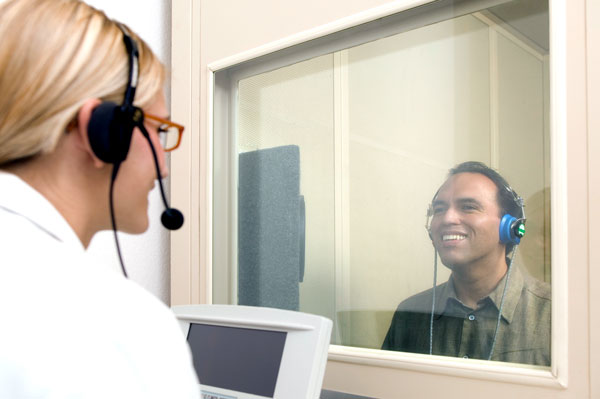The first step in diagnosing hearing loss is to undergo a hearing evaluation. A comprehensive evaluation consists of a series of individual tests that will help determine the extent and type of hearing loss. The audiologists at Soundchoice are skilled in conducting a number of hearing tests to help figure out a solution to your condition.
The Importance of Hearing Tests
Not all patients who experience hearing loss are aware of their condition. Symptoms tend to develop gradually over an extended period of time. Hearing tests may help detect a problem early, improving your chances of successful treatment.

Even if you do not suspect hearing loss, regular hearing tests should be considered a necessary part of your overall health screening once you reach the age of 50. And they’re not just for older adults; babies and toddlers should have their hearing tested in order to prevent delays in speech and language development should a hearing impairment exist.
Hearing tests are completely safe and painless. They are performed in a soundproof booth and results are plotted on a graph that shows your hearing response at different frequencies. This is called an audiogram, and will help the audiologist determine the best way to treat your hearing loss.
Types of Hearing Tests
A typical hearing evaluation is comprised of a number of separate hearing tests, including:
-
Pure Tone Testing
Pure-tone testing (also known as pure tone audiometry) uses air conduction to measure your ability to hear sounds of various pitches and volumes. Wearing headphones, you will be asked to identify a series of tones by raising a hand, pressing a button, or responding verbally. The results are charted on an audiogram, a graph that shows the type, degree and configuration of your hearing loss by comparing pitch (frequency) with loudness (intensity). The pattern recorded will help your audiologist determine your hearing threshold.
-
Bone Conduction Testing
Bone conduction testing is another type of pure-tone test that measures the inner ear’s response to sound. In this case, a two-pronged metal tuning fork is placed behind the ear or on the forehead. When vibrated, it produces a tone that travels to the cochlea via the skull. Your response determines how well sound travels through different parts of your ear, helping the audiologist diagnose your type of hearing loss. Bone conduction testing is often used in place of air conduction testing when an obstruction in the outer or middle ears is present.
-
Speech Testing
Speech (or word recognition) testing is used to measure your speech reception threshold (SRT), or the faintest speech you can understand 50 percent of the time. This is compared with your pure-tone test results to confirm the diagnosis. In addition, your ability to separate speech from background noise will be recorded. Speech testing may be administered in either a quiet or noisy environment; results are recorded on the audiogram for easy visual reference.
-
Tympanometry
Tympanometry is a test of the middle ear used to detect fluid, wax buildup, eardrum perforations and tumors. It measures movement of the eardrum in response to air pressure; the results are recorded on a chart called a tympanogram.
-
Acoustic Reflex Testing
The acoustic reflex test measures involuntary muscle contractions of the middle ear, and is used to determine the location of your hearing problem (the ossicles, cochlea, auditory nerve, etc.) as well as the type of hearing loss.
-
Auditory Brainstem Response (ABR).
Auditory brainstem response testing is used to determine whether a specific type of hearing loss—sensorineural—exists. It is also frequently used to screen newborns for hearing problems. In an ABR test, electrodes are attached to your head, scalp or earlobes, and you are given headphones to wear. Your brainwave activity is measured in response to sounds of varying intensities.
-
Otoacoustic Emissions (OAEs)
Otoacoustic emissions (OAEs) are sounds generated by vibrations of the hair cells in the cochlea of the inner ear. OAE testing utilizes a tiny probe fitted with a microphone and speaker that is used to stimulate the cochlea and measure its response. Individuals with normal hearing will produce emissions; when a hearing loss exceeds 25-30 decibels, no sound will be produced. This helps determine whether there is a blockage in the ear canal, excess fluid in the middle ear or damage to the hair cells of the cochlea. OAE testing is often included in newborn hearing screening programs.
